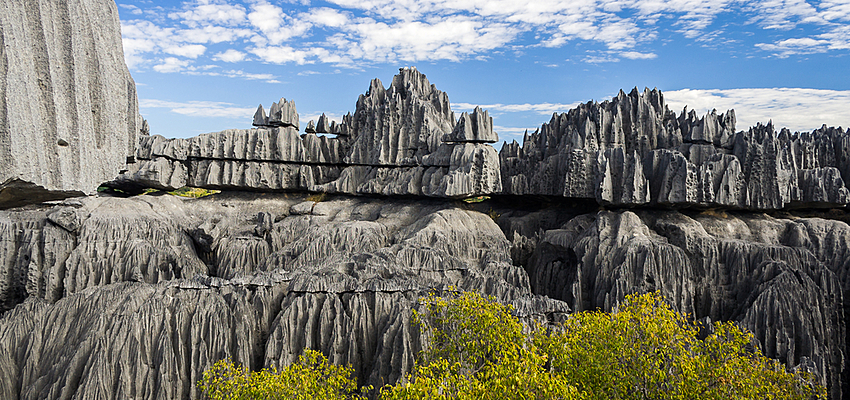Tsingy de Bemaraha’s national park consists of the throat of the river of Manambolo, the intact forests, the lakes and the mangrove swamps, the dense and dry forests, and the tsingy which make the fame and the magnificence of the site. “Tsingy” is points of sharp, high and ripped limestones.
The NATIONAL PARK OF TSINGY OF BEMARAHA
GEOGRAPHICAL SITUATION
The park is located in the Western center of Madagascar. The best means to reach it is by road starting from Morondava. First 4 WD is needed to face the 200km dirt road before getting at Bekopaka, the Southern entry of the park. The road lasts a little long but the landscape which it offers is worth the pain. The way goes through Belo sur Mer, a very convivial typical village where the population is cordial and the site quite charming. By the waterway via Ankavandra. It is a tour in the dugout along the Manambolo river Rowing and camping are within the program lasting at least three days. Washing in the natural swimming pools, tents are pitched on sand banks which give all the benefit to star gazing during the night and real nature which will not cease filling you. Lastly, by private chartered planes, small planes can land at the nearby small runway.
RELIEF
The national park of tsingy of bemaraha extends on a surface of 72340 ha. It is composed of the Gorge of the Manambolo river, lakes and mangroves, the dense dry and deciduous forests, and the tsingy which make the fame and the splendor of the site. The “tsingy” are pointed, high and jagged limestone points. The history tells that five million years ago, the vast limestone plate knew a river erosion which thus worked this spectacular landscape of peaks, faults and cracks that the “tsingy form”. Two rivers dominate the tsingy: Saohany and Manambolo. Manambolo is the starting point of the descent in the dugout.
CLIMATE
Of dry tropical type, the climate is marked by two seasons contrasts: one fresh and tepid from April to October and a hot and rainy period from November to March when it is impossible to pass there, for lack of access, roads are impracticable and hotels are closed. The tourist season is between June and November when it is dry. When the road is accessible, the park takes life again, visitors tributary. Precipitation can reach 1500mm per annum and the average temperature is 28°C. It should be noted that this temperature can go down to 9°C in July and go up until 38°C in December.
FAUNA AND FLORA the diversity of the site involve the variety of its animal and vegetation species. One noted the presence of - 13 species of lemurs including 3 diurnal and 10 nocturnal species such the sifaka or “Propithecus verreauxi”, the gidro or “Eulemur fulvus”, Aye aye or “Daubentonia Madagascariensis”.
› 90 species of terrestrial and water birds of which the rarest raptor in the world: the Madagascar Fish eagle which one often meets at the edge of the lakes or of the gorge, rails. Bernier teal is among the rarest wild duck in the world that one can also see there.
› 54 species of reptiles. The chameleons are very widespread such the “uroplatus” and “brookesia”, the crocodiles abound on the Manambolo and Sahoany rivers but they are shy, seldom attacks but on the contrary flee on seeing the dugouts.
› 15 species of bats – The fosa or” Cryptoprocta ferux”, the biggest Malagasy carnivorous about the size of a dog which is nocturnal, the mongoose and several species of Amphibians.
As for the flora, it is especially characterized by the presence of a dense dry deciduous. One can say that among its 650 plant species 85% are endemic and can attract the botanists. Rare plants lovers will appreciate and will be under the charms of the various adaptation forms like: plants which do not have leaves but only thorns in their place to limit the water loss, the trunks of the shrubs are large to be able to store water, several dwarf vegetations, of the large trees such “Dalberdia sp, Commiphora sp, hildegardia erythosiphon”, of the fatty plants, euphorbiums and kalanchoe, of pachypodium and the fig trees. The baobab trees shouldn’t be ommited as it is very current in this Western part of he country.
TOURIST INTEREST attractions of the park remain centered on the discovery of its “tsingy”. Walks are the best to explore the interior of the park and to appreciate the nature and breathtaking landscape while visiting the park, so unique, that UNESCO classified it as part of its World Heritage in 1990. The site is very well arranged that active people will be pleased to involve themselves during tsingy climbing… We can say that everyone can find its happiness there. Botanists, ornithologists, speleologists, photographers, lemur lovers, active people will not be ready to forget this adventure of the century. While just walking in the great tsingy, you will contribute your share on the local population development; you will take part in their source of income. And they will be thankful to you by keeping intact this single nature which we all try to preserve. For every one’s interest, various trails were established

